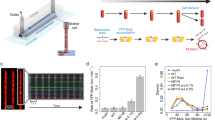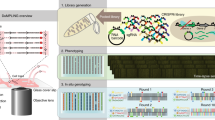Abstract
Mutations are the driving force of evolution and the source of important pathologies. The characterization of the dynamics and effects of mutations on fitness is therefore central to our understanding of evolution and to human health. This protocol describes how to implement two methods that we recently developed: mutation visualization (MV) and microfluidic mutation accumulation (µMA), which allow the occurrence of mutations created by DNA replication errors (MV) and the evolution of cell fitness during MA (µMA) to be followed directly in individual cells of Escherichia coli. MV provides a quantitative characterization of the dynamics of mutation occurrences, and µMA allows precise estimation of the distribution of fitness effects (DFEs) of mutations. Both methods use microfluidics and time-lapse microscopy, and a fluorescent mismatch repair (MMR) MutL protein is used as a marker for nascent mutations. Here, we present a single protocol describing how to implement the MV and µMA methods, including detailed procedures for microfluidic setup installation, data acquisition and data analysis and interpretation. Using this procedure, the microfluidic setup installation can be completed within 1 d, and automated data acquisition takes 2–4 d.
This is a preview of subscription content, access via your institution
Access options
Access Nature and 54 other Nature Portfolio journals
Get Nature+, our best-value online-access subscription
$29.99 / 30 days
cancel any time
Subscribe to this journal
Receive 12 print issues and online access
$259.00 per year
only $21.58 per issue
Buy this article
- Purchase on Springer Link
- Instant access to full article PDF
Prices may be subject to local taxes which are calculated during checkout




Similar content being viewed by others
Data availability
No datasets were generated or analyzed during the current study. Datasets from a related study are archived at Dryad (https://doi.org/10.5061/dryad.75625).
References
Robert, L. et al. Mutation dynamics and fitness effects followed in single cells. Science 359, 1283–1286 (2018).
Luria, S. E. & Delbruck, M. Mutations of bacteria from virus sensitivity to virus resistance. Genetics 28, 491–511 (1943).
Foster, P. L. Methods for determining spontaneous mutation rates. Methods Enzymol. 409, 195–213 (2006).
Frenoy, A. & Bonhoeffer, S. Death and population dynamics affect mutation rate estimates and evolvability under stress in bacteria. PLoS Biol. 16, e2005056 (2018).
Nishant, K. T., Singh, N. D. & Alani, E. Genomic mutation rates: what high-throughput methods can tell us. Bioessays 31, 912–920 (2009).
Mukai, T. The genetic structure of natural populations of Drosophila melanogaster. I. Spontaneous mutation rate of polygenes controlling viability. Genetics 50, 1–19 (1964).
Eyre-Walker, A. & Keightley, P. D. The distribution of fitness effects of new mutations. Nat. Rev. Genet. 8, 610–618 (2007).
Halligan, D. L. & Keightley, P. D. Spontaneous mutation accumulation studies in evolutionary genetics. Annu. Rev. Ecol. Evol. Syst. 40, 151–172 (2009).
Heilbron, K., Toll-Riera, M., Kojadinovic, M. & MacLean, R. C. Fitness is strongly influenced by rare mutations of large effect in a microbial mutation accumulation experiment. Genetics 197, 981–990 (2014).
Elez, M. et al. Seeing mutations in living cells. Curr. Biol. 20, 1432–1437 (2010).
Wang, P. et al. Robust growth of Escherichia coli. Curr. Biol. 20, 1099–1103 (2010).
Ollion, J., Elez, M. & Robert, L. High-throughput detection and tracking of cells and intracellular spots in mother machine experiments. Nat. Protoc. https://doi.org/10.1038/s41596-019-0216-9 (2019).
Uphoff, S. Real-time dynamics of mutagenesis reveal the chronology of DNA repair and damage tolerance responses in single cells. Proc. Natl. Acad. Sci. USA 115, E6516–E6525 (2018).
Elez, M., Radman, M. & Matic, I. Stoichiometry of MutS and MutL at unrepaired mismatches in vivo suggests a mechanism of repair. Nucleic Acids Res. 40, 3929–3938 (2012).
Woo, A. C., Faure, L., Dapa, T. & Matic, I. Heterogeneity of spontaneous DNA replication errors in single isogenic Escherichia coli cells. Sci. Adv. 4, eaat1608 (2018).
Kaiser, M. et al. Monitoring single-cell gene regulation under dynamically controllable conditions with integrated microfluidics and software. Nat. Commun. 9, 212 (2018).
Dormeyer, M. et al. Visualization of tandem repeat mutagenesis in Bacillus subtilis. DNA Repair 63, 10–15 (2018).
Norman, T. M., Lord, N. D., Paulsson, J. & Losick, R. Memory and modularity in cell-fate decision making. Nature 503, 481–486 (2013).
Nakaoka, H. & Wakamoto, Y. Aging, mortality, and the fast growth trade-off of Schizosaccharomyces pombe. PLoS Biol. 15, e2001109 (2017).
Foster, P. L., Lee, H., Popodi, E., Townes, J. P. & Tang, H. Determinants of spontaneous mutation in the bacterium Escherichia coli as revealed by whole-genome sequencing. Proc. Natl. Acad. Sci. USA 112, E5990–E5999 (2015).
Schaaper, R. M. Escherichia coli mutator mutD5 is defective in the mutHLS pathway of DNA mismatch repair. Genetics 121, 205–212 (1989).
Elez, M., Radman, M. & Matic, I. The frequency and structure of recombinant products is determined by the cellular level of MutL. Proc. Natl. Acad. Sci. USA 104, 8935–8940 (2007).
Negishi, K., Loakes, D. & Schaaper, R. M. Saturation of DNA mismatch repair and error catastrophe by a base analogue in Escherichia coli. Genetics 161, 1363–1371 (2002).
Gutierrez, A. et al. β-Lactam antibiotics promote bacterial mutagenesis via an RpoS-mediated reduction in replication fidelity. Nat. Commun. 4, 1610 (2013).
Harris, R. S. et al. Mismatch repair protein MutL becomes limiting during stationary-phase mutation. Genes Dev. 11, 2426–2437 (1997).
Maas, W. K., Wang, C., Lima, T., Hach, A. & Lim, D. Multicopy single-stranded DNA of Escherichia coli enhances mutation and recombination frequencies by titrating MutS protein. Mol. Microbiol. 19, 505–509 (1996).
Taheri-Araghi, S. & Jun, S. in Hydrocarbon and Lipid Microbiology Protocols: Single-Cell and Single-Molecule Methods (eds McGenity, T. J. et al.) 5–16 (Springer, 2015).
Ghigo, J. M. Natural conjugative plasmids induce bacterial biofilm development. Nature 412, 442–445 (2001).
Datsenko, K. A. & Wanner, B. L. One-step inactivation of chromosomal genes in Escherichia coli K-12 using PCR products. Proc. Natl. Acad. Sci. USA 97, 6640–6645 (2000).
Cooper, S. & Helmstetter, C. E. Chromosome replication and the division cycle of Escherichia coli B/r. J. Mol. Biol. 31, 519–540 (1968).
Zaritsky, A., Wang, P. & Vischer, N. O. Instructive simulation of the bacterial cell division cycle. Microbiology 157, 1876–1885 (2011).
Reyes-Lamothe, R., Possoz, C., Danilova, O. & Sherratt, D. J. Independent positioning and action of Escherichia coli replisomes in live cells. Cell 133, 90–102 (2008).
Acknowledgements
This work was funded by the Agence Nationale de Recherche (grant ANR-14-CE09-0015-01 to M.E.) and by the city of Paris (program Emergences 2018 to M.E.).
Author information
Authors and Affiliations
Contributions
L.R. and M.E. developed the protocol. J.O. developed the image analysis software. L.R., M.E. and J.O. wrote the manuscript.
Corresponding authors
Ethics declarations
Competing interests
The authors declare no competing interests.
Additional information
Peer review information Nature Protocols thanks Hanna Salman and the other, anonymous, reviewer(s) for their contribution to the peer review of this work.
Publisher’s note Springer Nature remains neutral with regard to jurisdictional claims in published maps and institutional affiliations.
Related links
Key reference using this protocol
Robert, L. et al. Science 359, 1283–1286 (2018): http://science.sciencemag.org/content/359/6381/
Key data used in this protocol
Robert, L. et al. Science 359, 1283–1286 (2018): http://science.sciencemag.org/content/359/6381/1283
Supplementary information
Rights and permissions
About this article
Cite this article
Robert, L., Ollion, J. & Elez, M. Real-time visualization of mutations and their fitness effects in single bacteria. Nat Protoc 14, 3126–3143 (2019). https://doi.org/10.1038/s41596-019-0215-x
Received:
Accepted:
Published:
Issue Date:
DOI: https://doi.org/10.1038/s41596-019-0215-x
This article is cited by
-
Real-time monitoring of replication errors’ fate reveals the origin and dynamics of spontaneous mutations
Nature Communications (2024)
-
Near-infrared co-illumination of fluorescent proteins reduces photobleaching and phototoxicity
Nature Biotechnology (2023)
-
Visualisierung von Mutationen auf Einzelzellebene
BIOspektrum (2020)
-
High-throughput detection and tracking of cells and intracellular spots in mother machine experiments
Nature Protocols (2019)
Comments
By submitting a comment you agree to abide by our Terms and Community Guidelines. If you find something abusive or that does not comply with our terms or guidelines please flag it as inappropriate.



